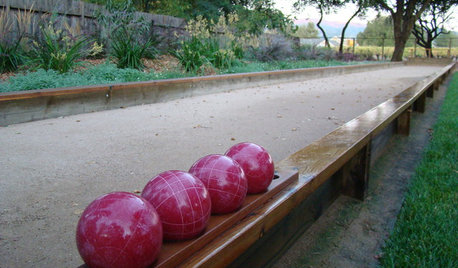adding sand to veg garden soil on expansive clay?
merrybookwyrm
12 years ago
Related Stories

GARDENING GUIDESHow to Stop Worrying and Start Loving Clay Soil
Clay has many more benefits than you might imagine
Full Story
GARDENING GUIDESGardening Solutions for Heavy Clay Soils
What’s a gardener to do with soil that’s easily compacted and has poor drainage? Find out here
Full Story
GARDENING GUIDESGet the Dirt on Your Garden’s Soil
Understand how your soil supports your plants so you can ensure your garden’s success
Full Story
CONTAINER GARDENSContainer Gardening Basics: The Dirt on Soil
Learn the types of potting soil available and the best mixes to help your containers thrive
Full Story
LANDSCAPE DESIGNHow to Shape a Rain Garden and Create the Right Soil for It
Learn how to grade, lay out and amend the soil in your rain garden to support your plants
Full Story
FARM YOUR YARDHow to Get Good Soil for Your Edible Garden
The nutrients in your soil feed the plants that feed you. Here are tips on getting it right — just in time for planting season
Full Story
GARDENING GUIDESGardening Solutions for Dry, Sandy Soils
Has your desert or beachy site withered your gardening creativity? Try these ideas for a beautiful, easy-care landscape
Full Story
GARDENING GUIDES5 Prairie Wildflowers That Can Heal Your Soil
Get free, organic soil fertilizer with nitrogen-pumping plants that draw pollinators too
Full Story
GARDENING GUIDES10 Solutions for Soggy Soil
If a too-wet garden is raining on your parade, try these water-loving plants and other ideas for handling all of that H2O
Full Story
GREAT HOME PROJECTSWhat to Know About Adding a Backyard Bocce Ball Court
A regulation court in a relaxed setting helps you get the most from the Italian pastime. Here's what it takes to build one at home
Full StoryMore Discussions







melvalena
tx_ag_95
Related Professionals
Clark Landscape Architects & Landscape Designers · Beachwood Landscape Contractors · Caldwell Landscape Contractors · Fort Payne Landscape Contractors · Hawthorne Landscape Contractors · Homewood Landscape Contractors · Lakeville Landscape Contractors · Lynwood Landscape Contractors · Rio Linda Landscape Contractors · Wareham Landscape Contractors · Centerville Stone, Pavers & Concrete · Annapolis Window Contractors · Fond du Lac Window Contractors · Muttontown Window Contractors · Seattle Window Contractorsweldontx
merrybookwyrmOriginal Author
novascapes
melvalena
wantonamara Z8 CenTex
cactusgarden
novascapes
carrie751
melvalena